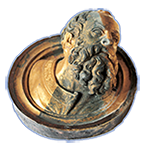Prompt gamma activation analysis (PGAA) and in-beam neutron activation analysis (in-beam NAA) offer a non-destructive panoramic analysis with fair detection limits for many elements. Non-destructivity is of extreme importance in archaeometry and cultural heritage research. Due to the low matrix dependence, many different object types can be analyzed – e.g. coins, stone artefacts and glasses....
With its diverse irradiation positions and very pure thermal neutron flux, the reactor FRM II offers good opportunities for investigations of chemical element composition in samples from different research fields. The reasons for using the instrumental NAA are based on the advantages of simple sample preparation without chemical handlings, high sensitivity, multi-element capability from the...
Varnish on easel painting has two objectives: protect the colored layer from external impact and saturate the colors of the pigments (esthetic role). Varnish is the first layer exposed to light, dust and other deteriorating factors. Thus, easel paintings loose their visual appearance making the observation and appreciation of the details of the artwork difficult. In order to reverse these...
The method of Neutron Resonance Capture Analysis (NRCA) is currently being developed in the Frank Laboratory of Neutron Physics (FLNP) for the purpose of determination of the element composition of samples. The method is based on registration neutron resonances in radiative capture and measurement the yield of reaction products in these resonances. The method is non-destructive, the induced...
PGAA techniques enjoy unique features of relevance to the materials characterisation, particularly for the non-destructive measurement of elemental (and isotope) composition. We present the development and test experiments on the use of meV to eV neutron beams for Multi-dimensional Prompt-Gamma Activation Analysis, and its integration into imaging and diffraction beam lines at the ISIS...
In this presentation we emphasize the complementary of neutron and x-ray methods in cultural heritage science on the basis of selected study cases on museum objects from different collections of the national museums in Berlin.
Information on the genesis of different easel paintings of the collection of the Gemäldegalerie (Painting Gallery), Staatliche Museen zu Berlin-Stiftung Preußischer...
Numismatics is a discipline extremely open to different influxes and approaches, spanning from archaeology to history, from statistics to economics. While for certain ages we have enough documentary sources to understand social and economic processes behind the production of coins, for other historical periods we need different research approaches. In these cases, materials whose coins are...
Amphorae of the Haltern 70 type were produced mainly in the Roman provinces of Hispania Baetica and Lusitania in the south of modern Spain during the second half of the first century BC and the first century AC. On the other hand, a large number of sherds of such amphorae was found in excavations of a Roman settlement at Castro do Vieito in the northwest of Portugal. Presumably, these amphorae...
Ancient and historic wooden artefacts are consolidated by soaking with organic consolidants. Some consolidants, as carbolineum, showed undesired effects and are to be removed. Both, introduction and removal process benefit from a known distribution of the consolidant inside of the object.
X-ray tomography is insufficient for this purpose since both, the wooden matrix and the impregnating...

